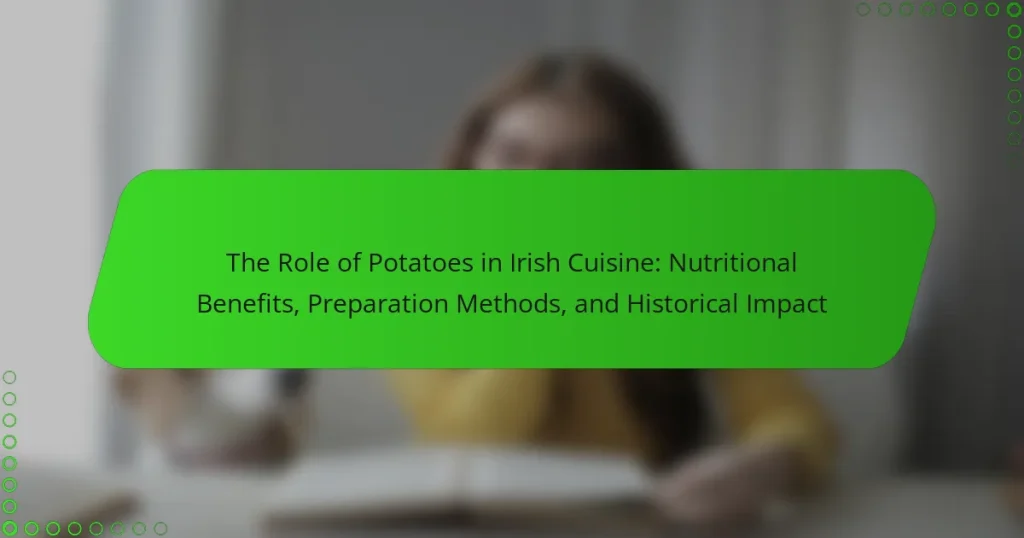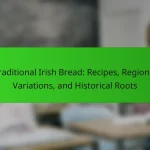Potatoes are a fundamental entity in Irish cuisine, integral to both nutrition and cultural identity. Introduced in the late 16th century, they quickly became a primary food source, rich in carbohydrates that provide essential energy. The article examines the nutritional benefits of potatoes, their various preparation methods such as boiling, baking, and mashing, and their historical significance, particularly during the Great Famine of the 19th century, which drastically affected Irish society. Additionally, traditional dishes like colcannon and boxty showcase the versatility of potatoes, while their enduring presence in festivals reflects their importance in Irish heritage.
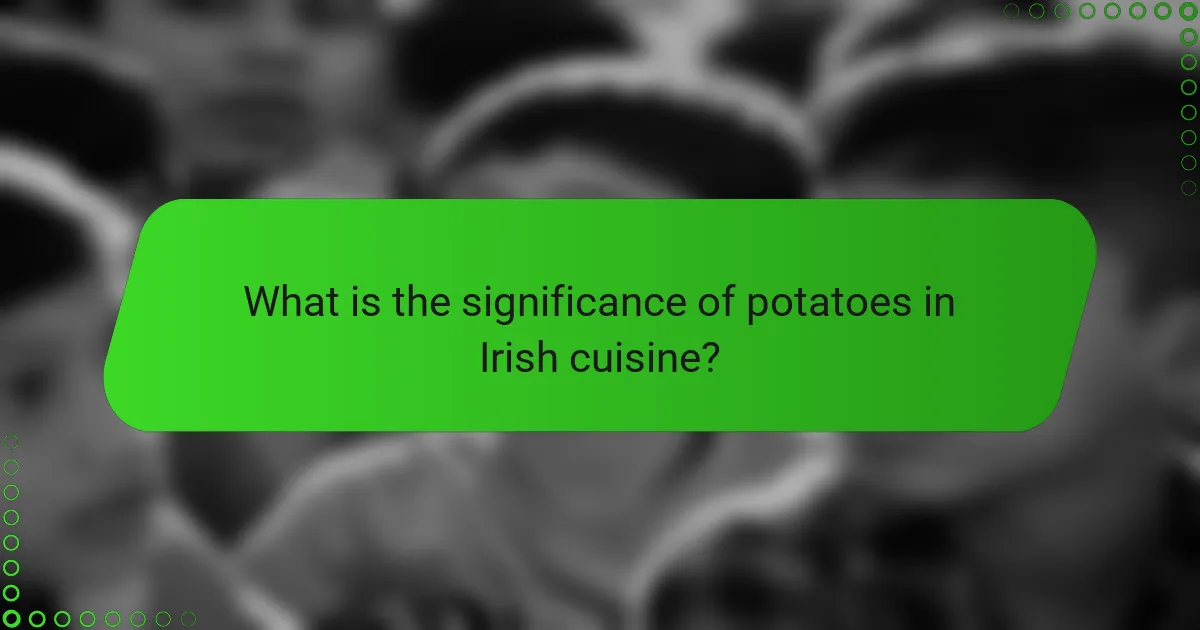
What is the significance of potatoes in Irish cuisine?
Potatoes are a staple food in Irish cuisine, crucial for both nutrition and cultural identity. They were introduced to Ireland in the late 16th century and quickly became a primary food source. Potatoes are rich in carbohydrates, providing essential energy for the population. During the Great Famine in the 19th century, the reliance on potatoes contributed to widespread hardship when crops failed. Traditional dishes such as colcannon and boxty highlight their versatility in Irish cooking. Today, potatoes remain a symbol of Irish heritage and culinary tradition. Their significance is reflected in various festivals and celebrations across Ireland.
How did potatoes become a staple in Irish diets?
Potatoes became a staple in Irish diets due to their high nutritional value and adaptability. Introduced in the late 16th century, they quickly thrived in Ireland’s climate. The crop was easy to grow and yielded a high caloric intake per acre. By the 18th century, potatoes constituted a significant portion of the Irish diet. This reliance on potatoes was further solidified by the Great Famine in the 1840s, which devastated other food sources. The famine highlighted the dependency on potatoes, leading to their prominence in Irish cuisine. Today, potatoes remain integral to traditional Irish dishes, showcasing their lasting impact.
What historical events influenced the introduction of potatoes in Ireland?
The introduction of potatoes in Ireland was influenced by the Columbian Exchange in the late 16th century. This exchange facilitated the transfer of crops, including potatoes, from the Americas to Europe. Potatoes were initially adopted in Ireland due to their high yield and nutritional value. The crop became a staple food during the 18th century, particularly among the rural poor. The Great Famine in the mid-19th century highlighted the reliance on potatoes as a primary food source. The failure of potato crops during this period led to widespread starvation and emigration. These events significantly shaped Irish agriculture and cuisine, cementing the potato’s role in Irish society.
Which regions in Ireland are most associated with potato cultivation?
The regions in Ireland most associated with potato cultivation are County Donegal, County Antrim, and County Down. These areas have historically provided suitable conditions for growing potatoes. The cool, moist climate and fertile soil contribute to successful potato farming. Additionally, the Irish Potato Famine in the 19th century highlighted the significance of these regions in potato agriculture. Today, they remain key areas for potato production in Ireland.
What are the nutritional benefits of potatoes?
Potatoes provide several nutritional benefits. They are rich in carbohydrates, primarily in the form of starch. A medium potato contains about 37 grams of carbohydrates. Potatoes also offer dietary fiber, with approximately 2.2 grams per medium potato. They are a good source of vitamins, particularly vitamin C, with about 30% of the daily recommended intake in one medium potato. Additionally, potatoes contain essential minerals like potassium, providing around 620 mg per medium potato. This mineral is important for heart health and muscle function. Potatoes are low in calories, with roughly 160 calories in a medium-sized one. They are naturally fat-free, making them a healthy option in various diets. Overall, potatoes are a versatile food that contributes to a balanced diet.
How do potatoes contribute to a balanced diet?
Potatoes contribute to a balanced diet by providing essential nutrients and energy. They are a rich source of carbohydrates, which serve as the body’s primary energy source. One medium potato contains about 37 grams of carbohydrates. Potatoes also provide dietary fiber, which aids in digestion and helps maintain gut health. A medium potato offers approximately 2 grams of fiber.
Additionally, potatoes are a good source of vitamins and minerals. They contain vitamin C, which supports the immune system and skin health. A medium potato provides about 30% of the daily recommended intake of vitamin C. Potatoes also contain potassium, which is vital for heart health and muscle function. A medium potato contains around 620 mg of potassium.
Moreover, potatoes are low in fat and cholesterol-free, making them a heart-healthy food choice. When prepared healthily, such as baking or boiling, they can be an integral part of a nutritious diet. Overall, potatoes can enhance dietary variety and provide essential nutrients for maintaining overall health.
What vitamins and minerals are abundant in potatoes?
Potatoes are abundant in vitamins and minerals. They are particularly rich in vitamin C, providing about 30% of the daily recommended intake per medium potato. Potatoes also contain vitamin B6, which plays a crucial role in metabolism and brain health. Additionally, they are a good source of potassium, with approximately 620 mg per medium potato, which helps regulate blood pressure. Iron is present in smaller amounts, contributing to overall health. Furthermore, potatoes provide dietary fiber, which supports digestive health. The nutritional profile makes potatoes a valuable food source in many diets.
How do different cooking methods affect the nutritional value of potatoes?
Different cooking methods significantly affect the nutritional value of potatoes. Boiling potatoes can lead to a loss of water-soluble vitamins, especially vitamin C and some B vitamins. Steaming, on the other hand, preserves more nutrients compared to boiling because it minimizes water exposure. Baking potatoes retains most nutrients, but the skin should be kept on for maximum fiber and nutrient retention. Frying potatoes increases calorie content and can produce harmful compounds if done at high temperatures. Microwaving is a quick method that retains nutrients effectively, similar to steaming. Research indicates that cooking methods impact antioxidant levels in potatoes, with steaming preserving more antioxidants than boiling.
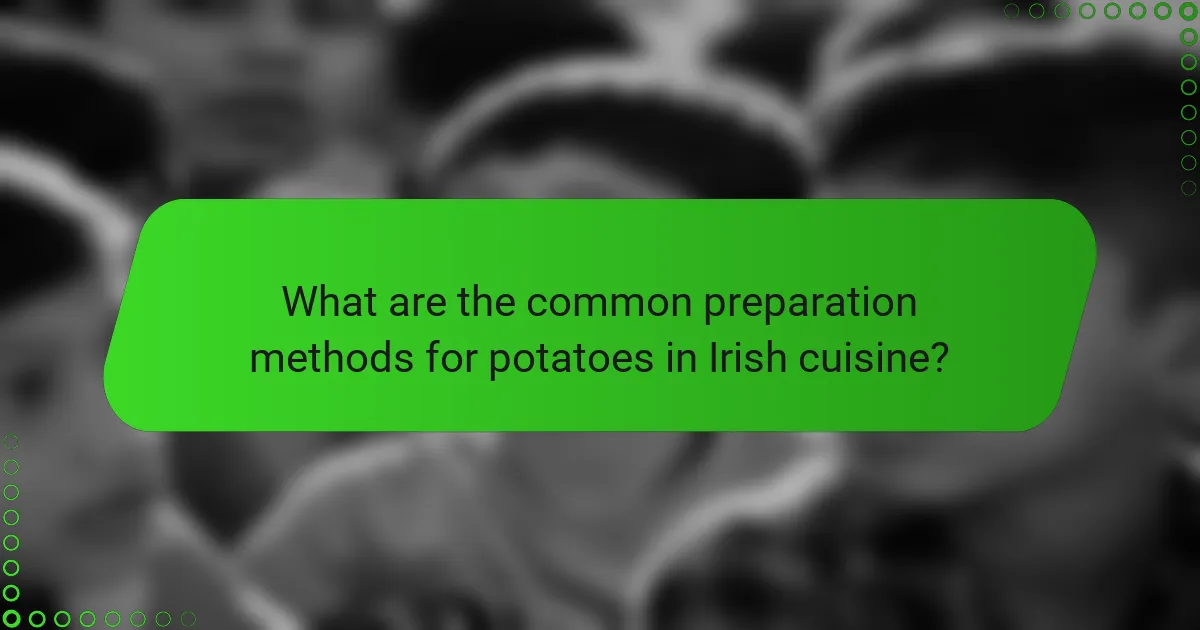
What are the common preparation methods for potatoes in Irish cuisine?
Common preparation methods for potatoes in Irish cuisine include boiling, baking, and mashing. Boiling is often used for making dishes like colcannon. Baking produces a crispy texture, commonly seen in baked potatoes. Mashing creates a creamy consistency, essential for traditional dishes. Other methods include roasting, which enhances flavor, and frying, used for making chips. These methods reflect the versatility of potatoes in Irish cooking. Historical records indicate that potatoes became a staple food in Ireland during the 17th century, influencing these preparation techniques.
How are potatoes traditionally prepared in Irish households?
Potatoes are traditionally prepared in Irish households by boiling, mashing, and baking. Boiling is a common method, often used for making dishes like colcannon, which combines mashed potatoes with cabbage or kale. Mashing potatoes is another staple preparation, typically seasoned with butter and milk. Baking potatoes is also popular, especially for serving as a side dish. These methods have historical roots, with potatoes being a dietary staple in Ireland since the 17th century. Their versatility and ease of preparation contribute to their prominence in Irish cuisine.
What are popular Irish potato dishes?
Popular Irish potato dishes include colcannon, champ, and boxty. Colcannon combines mashed potatoes with cabbage or kale. This dish has roots in Irish tradition and is often served during celebrations. Champ consists of mashed potatoes mixed with scallions and butter. It is a comforting staple in Irish households. Boxty is a type of potato pancake made from grated and mashed potatoes. This dish showcases the versatility of potatoes in Irish cooking. Other notable dishes include potato farls and shepherd’s pie, which also highlight the importance of potatoes in Irish cuisine.
How do preparation methods vary across different regions of Ireland?
Preparation methods for potatoes vary significantly across different regions of Ireland. In the west, particularly in counties like Galway and Kerry, potatoes are often boiled and served with butter. This method highlights the natural flavor of the potato. In contrast, the northern regions, such as Antrim and Down, tend to favor frying potatoes, creating crispy dishes like potato farls. In the east, particularly Dublin, mashed potatoes are a staple, often incorporated into traditional dishes like shepherd’s pie. The use of different preparation methods reflects local tastes and agricultural practices. For example, the abundant rainfall in the west produces moist, creamy potatoes ideal for boiling. Meanwhile, the drier climate in the north supports a firmer potato suitable for frying. Each region’s unique culinary traditions showcase the versatility of potatoes in Irish cuisine.
What modern adaptations exist for traditional Irish potato recipes?
Modern adaptations of traditional Irish potato recipes include various innovative cooking techniques and ingredient substitutions. For example, traditional colcannon has been reimagined with kale or spinach instead of cabbage. Mashed potatoes are often enhanced with garlic, cheese, or sour cream for richer flavors.
Additionally, potato cakes are now frequently made with sweet potatoes for a healthier twist. Another adaptation is using potatoes in fusion dishes, such as potato tacos or potato gnocchi.
These modern recipes maintain the essence of the original dishes while appealing to contemporary tastes and dietary preferences. This trend reflects a broader movement in cooking that embraces creativity and health-conscious eating.
How have contemporary cooking techniques changed potato preparation?
Contemporary cooking techniques have significantly transformed potato preparation. Techniques such as sous-vide allow for precise temperature control, enhancing flavor and texture. Air frying offers a healthier alternative to traditional frying, reducing oil usage while maintaining crispiness. Molecular gastronomy introduces innovative methods, like potato foam, which alters texture and presentation. Additionally, steam cooking retains nutrients better than boiling. These modern methods cater to health-conscious consumers and elevate culinary creativity. Studies show that these techniques improve the overall sensory experience of potatoes, making them more appealing in various dishes.
What fusion dishes incorporate potatoes in innovative ways?
Fusion dishes that incorporate potatoes in innovative ways include potato gnocchi with Asian-inspired sauces. This dish combines Italian gnocchi with flavors like soy sauce and sesame oil. Another example is the Korean potato pancake, or jeon, which merges traditional Korean techniques with potato as a primary ingredient. Loaded potato tacos blend Mexican and American cuisines, using mashed potatoes as a filling. Furthermore, Indian aloo tikki burgers fuse spiced potato patties with Western-style burger components. These dishes showcase the versatility of potatoes across various culinary traditions.
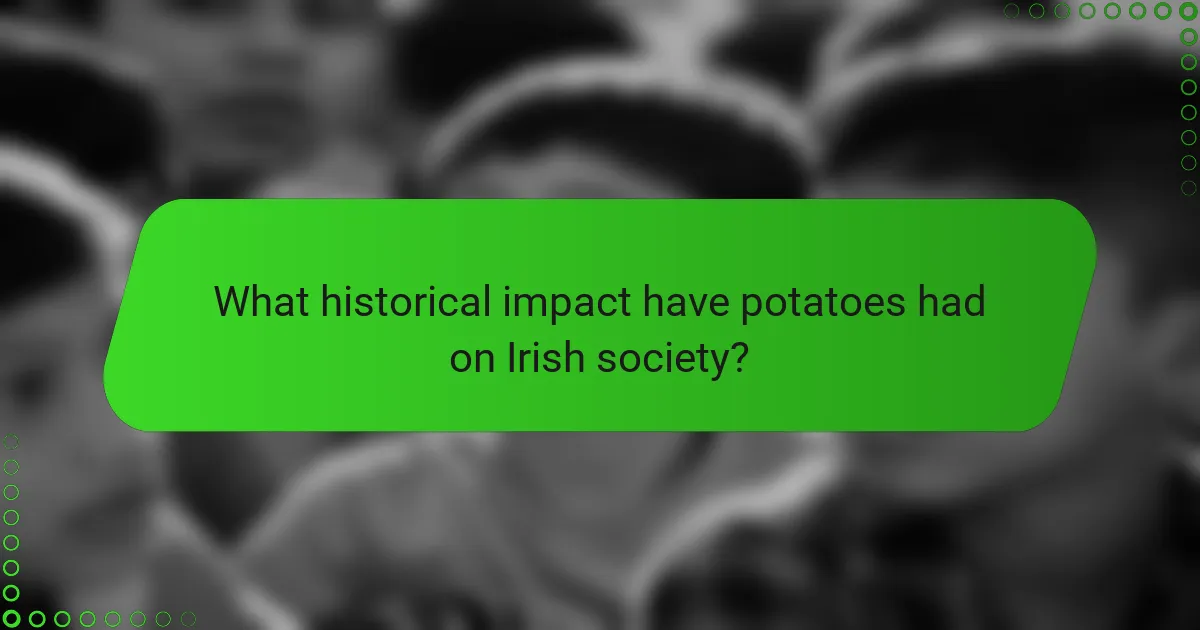
What historical impact have potatoes had on Irish society?
Potatoes significantly impacted Irish society, particularly during the 19th century. They became a staple food, providing essential nutrition for the population. By the 1840s, potatoes accounted for a large portion of the Irish diet. This reliance made the population vulnerable to crop failures. The Great Famine from 1845 to 1852 resulted from potato blight. Approximately one million people died due to starvation and disease. Another million emigrated to escape the crisis. The famine profoundly altered Irish demographics and society. It led to increased awareness of agricultural dependency and food security issues.
How did the Great Famine shape perceptions of potatoes in Ireland?
The Great Famine significantly altered perceptions of potatoes in Ireland. Prior to the famine, potatoes were a staple food, praised for their nutritional value and versatility. The famine, which lasted from 1845 to 1852, resulted from potato blight, leading to widespread crop failure. This devastation caused mass starvation and death, with about one million people dying and another million emigrating. Consequently, potatoes became associated with suffering and loss. Many viewed them as a symbol of poverty and despair. This shift led to a decline in their consumption in favor of other crops. The famine transformed potatoes from a beloved staple to a food associated with tragedy.
What were the socio-economic effects of potato dependence in Ireland?
Potato dependence in Ireland led to significant socio-economic effects. The reliance on a single crop made the population vulnerable to famine. The Great Famine from 1845 to 1852 resulted from potato blight, causing approximately one million deaths. This crisis caused mass emigration, with over two million people leaving Ireland during the 19th century. The agricultural economy suffered as many farmers lost their livelihoods. Land ownership patterns shifted, concentrating wealth among fewer landlords. Social structures were disrupted, leading to increased poverty and hardship for the rural population. These socio-economic changes had lasting impacts on Irish society and demographics.
How is the legacy of the potato famine reflected in modern Irish culture?
The legacy of the potato famine is reflected in modern Irish culture through remembrance and resilience. Commemorative events, such as the annual famine memorials, honor the victims. These events foster a collective memory of loss and survival. Irish literature and art often explore themes related to the famine. This includes works that depict the struggles faced during that time. Traditional Irish music frequently references the famine and its impact on communities. The potato remains a staple in Irish cuisine, symbolizing cultural identity. Furthermore, discussions about food security and agriculture today echo lessons from the famine period. These cultural elements highlight the enduring significance of the potato famine in shaping modern Irish society.
What role do potatoes play in Irish celebrations and traditions?
Potatoes are central to Irish celebrations and traditions. They symbolize sustenance and resilience in Irish culture. During events like St. Patrick’s Day, potatoes are often featured in traditional dishes. Colcannon, a dish made with mashed potatoes and cabbage, is commonly served. Potatoes were historically significant during the Great Famine, shaping cultural identity. They represent a connection to the land and heritage. The Irish Potato Famine led to the diaspora, influencing global Irish celebrations. Today, potatoes remain a staple in festive meals, reflecting their enduring importance.
How are potatoes featured in traditional Irish festivals?
Potatoes are a central element in traditional Irish festivals. They are often featured in various dishes served during celebrations. Festivals such as St. Patrick’s Day highlight potato dishes like colcannon and champ. These dishes symbolize Irish heritage and community spirit. Potatoes are also used in competitions and games at local festivals. The significance of potatoes reflects their historical importance in Irish culture. They served as a staple food during the Great Famine, which shaped modern Irish identity. Overall, potatoes play a vital role in the culinary traditions celebrated during Irish festivals.
What symbolic meanings do potatoes hold in Irish folklore?
Potatoes symbolize sustenance and resilience in Irish folklore. They are often associated with the Great Famine, which led to widespread suffering. This connection emphasizes the potato’s role as a staple food that sustained the population. In folklore, potatoes also represent fertility and prosperity, reflecting their importance in agricultural life. Additionally, they are linked to various myths and legends, showcasing their cultural significance. The potato’s adaptability to Irish soil further highlights its value in survival and sustenance during hardships. Overall, potatoes embody themes of survival, resilience, and cultural identity in Irish folklore.
What are some practical tips for incorporating potatoes into daily meals?
Incorporating potatoes into daily meals can enhance nutrition and flavor. Start by boiling or steaming potatoes for a healthy side dish. Mashed potatoes can serve as a comforting base for various proteins. Roasting potatoes with herbs adds a crispy texture and rich taste. Include diced potatoes in soups or stews for heartiness and substance. Use baked potatoes as a versatile canvas for toppings like cheese, sour cream, or vegetables. Make potato salads with fresh ingredients for a refreshing dish. For breakfast, consider adding potatoes to omelets or hash. Each method retains the nutritional benefits of potatoes, which are rich in vitamins C and B6, potassium, and fiber.
The primary entity of this article is potatoes, which play a crucial role in Irish cuisine. The article explores the nutritional benefits of potatoes, including their rich carbohydrate content and essential vitamins and minerals. It outlines various preparation methods commonly used in Irish households, such as boiling, mashing, and baking, while also discussing popular dishes like colcannon and champ. Additionally, the article examines the historical significance of potatoes in Ireland, particularly during events like the Great Famine, and highlights their cultural symbolism in Irish celebrations and folklore.
